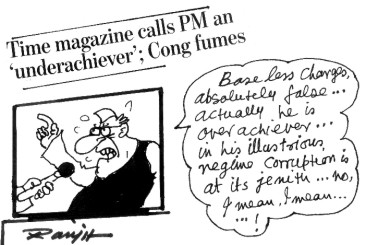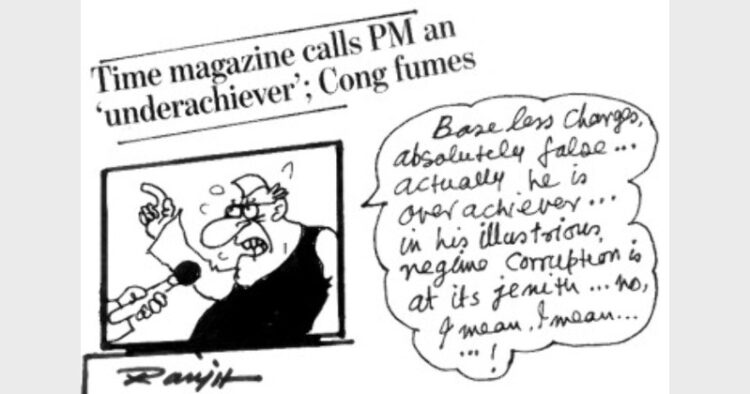
Dr Bharat Jhunjhunwala
 “Trickle-down theories do not address the legitimate aspirations of the poor… Our national mission must continue to be… to create such opportunities for the young that they can take our India forward by quantum leaps,” said Pranab Mukherjee in his first speech after becoming the 13th President of India. Pure music!
“Trickle-down theories do not address the legitimate aspirations of the poor… Our national mission must continue to be… to create such opportunities for the young that they can take our India forward by quantum leaps,” said Pranab Mukherjee in his first speech after becoming the 13th President of India. Pure music!
Problem lies in the model espoused by Manmohan Singh. Jobs are evaporating into thin air while profits of corporations are rising. This state of affairs is rooted in the ‘trickle-down’ theory espoused by him. Thinking is that a part of the increased incomes of the rich will trickle-down to the poor and thereby provide increased incomes to all people. The logic runs like this: Income of the corporate barons will increase when the price of shares owned by them rises. Price of shares will rise when the companies increase production and make profits. Increase in production will require employment of larger numbers of workers. In this way incomes of the rich will trickle-down to the common man.
Trickle-down does not work, unfortunately. It is not necessary for the corporations to employ larger number of workers in order to increase their profits or production. These can be increased by the use of automatic machines. Increase in production and reduced employment can go together. Readers will note that share markets generally applaud whenever a company goes for downsizing, i.e., reducing the number of employees. Workers are nowadays treated by businessmen as a necessary evil.
An alternative formulation of the trickle-down theory is that higher profits by the corporations will enable the Government to collect more taxes which can be used to raise the living standards of the poor such as by redistribution under the Employment Guarantee Scheme and the like. This too does not work. A large share of the monies spent in welfare programmes is pocketed by the welfare mafia of government servants as salaries and commissions. The poor gets a trickle of the trickle; while the well-paid government servants make merry.
Even if the trickle of the trickle reaches the poor, it does not help in controlling social unrest because inequality increases more rapidly. A quick calculation indicates that income of the rich will have to increase by Rs 30,000 to provide Rs 100 to the poor. Thus, even if the trickle can help alleviate the deepest poverty, it will only fuel inequality—which is socially explosive.
Economists will have to think afresh. ‘Work’ is increasingly becoming irrelevant because of the development of new labour saving technologies. In a way this is a happy development. Man is no longer required to work in order to earn his bread. Few hundred workers working with tractors and automatic looms can produce all the food and cloth that is required by thousands of households. Remaining workers are no longer required by the economy. This is good if those who are left out can be provided with the wherewithal to live and to realise their potential. However, the same redundance is painful if they have to beg for unemployment compensation and have no wherewithal to paint, fish, dance and explore the beauty of life.
We may examine some of the proposed solutions to the problem in this backdrop. Proposal is to increase number of Government jobs—recruit sweepers for the villages and teachers for Government schools. This approach cannot go very far. It will be necessary to collect more taxes from the rich to pay the newly recruited government servants; which is possible only if the rich earn yet more.
Second issue is of delivery of public services. Rajiv Gandhi had estimated that only 15 per cent of the monies reach the intended beneficiaries. The situation has only worsened since then. The Congress and BJP want to solve this issue by implementing administrative reforms such as the incentive system for government servants proposed by the Sixth Pay Commission. They also want to target subsidies towards the poor. All efforts in this direction have been a big zero in the last sixty years because the nature of Government employees is like a magnet which pulls everything to itself. People have to make special efforts to get anything from the Government just as one has to wrest apart a piece of iron stuck in the magnet.
We need to think differently. We need to make economic policies that provide relief to the common man by reducing the incomes of the rich. Gandhian Annasahib Sahasrabuddhe had suggested that all cloth for domestic consumption be necessarily produced on handlooms. That would lead to fewer profits for the textile mills and more incomes for labour. The cost of cloth will also be more but this should be seen as an ‘employment tax’.
Secondly, all subsidies should be combined in a single fund and the money should be sent to the voters listed in the electoral rolls directly by the Reserve Bank of India by cheque. All subsidies must simultaneously be extinguished. The costs incurred by the Central Government on various subsidies in 2007 were about Rs 220k crore. This included subsidies on food, education, health, employment guarantee, housing, fertilizer and oil subsidy. This would be about Rs 350k crore today. Add the monies being spent by the State Governments and the figures bloats to about Rs 700k crore. This money can be distributed equally among the 55 crore voters. This will amount to Rs 13,000 per voter per year or about Rs 26,000 per family per year. People can buy food, health and education of their liking from the market. Problem, of course, is that the welfare mafia will be hit.
New thinking is also required on land reforms. Congress has put this matter in perpetual cold storage. These reforms, even if implemented, will not go very far. Land has already been so drastically fragmented that further division will not enable the recipients to make a comfortable living. More importantly, the poor will get locked into low-incomes of agriculture. The share of agriculture in our national income has declined from about 56 per cent in 1951 to 20 per cent presently and the trend continues to become stronger with every passing day. There are limits to new investments that can be made on an acre of agricultural land. Accordingly the production and incomes of farmers is also limited. Most incomes are being generated and employment is being created in the cities. Many scholars hold that expansion of the market economy has enabled the poor to migrate to the cities and helped break the age-old caste barriers. Land reforms should, therefore, be made an instrument of helping the common man reach the city where new opportunities are emerging in services. Instead of distributing plots of agricultural land, we must distribute plots in towns and cities to the landless. That would help them migrate to the cities and make a better living.
(The writer is a Gandhian thinker and veteran columnist on economic affairs).














Comments